 When looking for the best wire rope, it’s important to understand the different classifications. Wire rope consists of steel wires twisted together to create independent strands. Those strands surround a core in a helix. Wire rope is commonly used in heavy lifting situations because it’s flexible and durable. Each wire rope type will have its advantages and disadvantages. The material you select will depend on your specific needs.
When looking for the best wire rope, it’s important to understand the different classifications. Wire rope consists of steel wires twisted together to create independent strands. Those strands surround a core in a helix. Wire rope is commonly used in heavy lifting situations because it’s flexible and durable. Each wire rope type will have its advantages and disadvantages. The material you select will depend on your specific needs.
Wire rope classification refers to the total number of strands and the number of wires in each strand. Let’s go over common wire rope configurations in specific classifications:
- Compact Strand Wire Rope – This type of wire rope is designed by compressing strands through rollers or a die. This process results in a smaller overall diameter.
- Plastic Coated Wire Rope – This classification has a layer of plastic covering the entire rope providing abrasion resistance and protecting the wire from chemicals and environmental elements.
- Rotation-Resistant Wire Rope – Some wire rope classifications are prone to rotation with high loads. Rotation-resistant wire can resist spinning or twisting. This type of wire can work in a multi-part or single-line configuration.
- Plastic-Filled IWRC Wire Rope – This wire rope is ideal because it combines the benefits of plastic filling with an individual wire rope core (IWRC).
- Compact/Swaged Wire Rope – This wire is created by compressing together alternating wire to form one solid core strand. Once the wire is closed, a rotary swager machine shrinks or compacts the diameter.
Call us for all your wire rope NY needs. We’ll help you find the correct rope for you.
Related Reading about Wire Rope